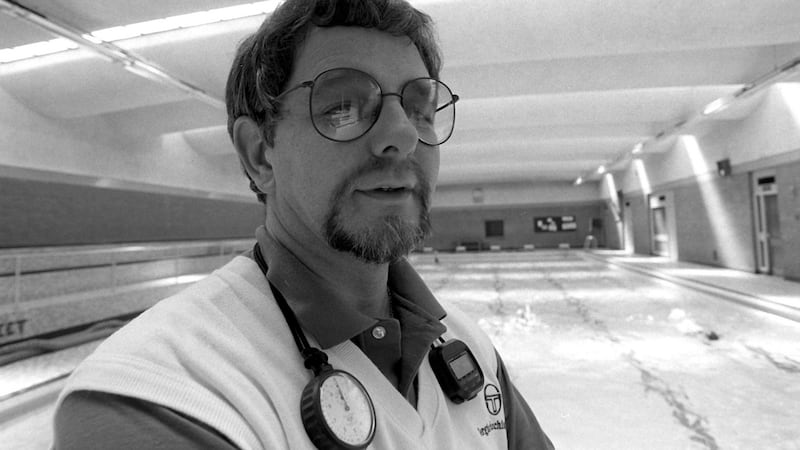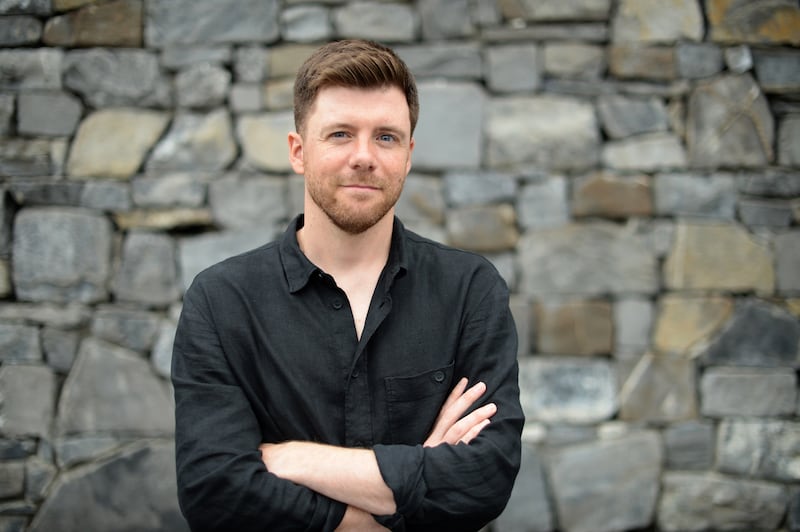Earlier this week, not long after The Irish Times had printed the story of George Gibney’s arrest in the United States under the headline “George Gibney facing 79 charges relating to alleged sexual abuse of four girls,” my phone pinged.
“I am so glad. But feel sad for 13 yr old me and 9 yr old Ber, who were not believed,” it said.
The text was from Tric, a talented swimmer, who had been one of six people involved in a case in Ireland against Gibney in the 1990s that was halted in the Supreme Court.
The sentiment had nothing to do with self-pity but the name, the arrest, the charges hit hard, like an emotional jolt from the past.
READ MORE
The broad outline of the allegation in the news story about Gibney’s US arrest was not dissimilar to the case involving Tric Kearney, Ber Carley and others.
The latest legal filings lodged in the US district court showed that Gibney had been accused of 78 counts of indecent assault and one count of attempted rape over the alleged sexual abuse of four girls and the alleged attempted rape of one of the girls.
Much like those allegations made decades ago, all four girls were minors, aged between eight and 15, and were coached by Gibney at the time of the alleged abuse.
The text was a reminder that sometimes in the glare of headlines and the frenzy of how quickly news moves, how many charges are brought and how many people are involved, the human cost to nine- and 13-year-old girls can be forgotten.

The original 1993 charges, at Dún Laoghaire District Court, were 27 counts of indecent assault and unlawful carnal knowledge of young female swimmers under the age of 15.
But no case was ever heard in Dublin. Gibney’s accusers have never had their day in court and that has been a devastating truth to live with and a source of deep frustration for more than 30 years.
Gibney’s lawyer argued in an Irish Supreme Court judicial review at the time that he could not defend himself, as some of the allegations went back to the 1960s.
It was true, some charges did go back that far. But some were also from the 1980s, just 11 years earlier.
The line of defence that allegations reached too far back in time was an idea that became a dark in-joke to those involved in the case. It was simultaneously absurd and enraging.
Gibney had introduced modern ways of training to his athletes. Before his name became synonymous with allegations of abuse, he was diligent and detailed and encouraged swimmers to keep meticulous diaries so that if they swam a national or event record, they could look back and see what training they had been doing to get the time. They kept their diaries.
Following on from the Supreme Court ruling, Mr Justice Declan Costello in the High Court granted an order prohibiting the Director of Public Prosecutions, Eamonn Barnes, from proceeding with the charges against Gibney. Leave to appeal was granted but no appeal was made by the State.
Gibney left Ireland when he was released in July 1994, a free and innocent man in the eyes of the courts.
By then the Sunday Tribune (where I was working at the time), along with Gibney’s star swimmer of the time, Gary O’Toole, a double Olympian from Seoul and Barcelona, and European Championship silver medallist, had taken up the story and published details of the allegations against the coach.

In an unusual request, all swimmers who were mentioned in the Sunday Tribune were asked for sworn affidavits and agreed to be interviewed by the newspaper’s defamation lawyer Hugh Mohan.
For surety, more legal advice was taken from barrister and future Supreme Court judge Adrian Hardiman. The assumption was that Gibney would sue. But he did not.
By the time the story was published he was already on the move and turned up in Warrender Baths Swimming Club in Scotland, working as a coach.
Warrender, who had a medical doctor on their board, were horrified when informed of the allegations made in Ireland. By the end of 1994 Gibney was sacked and fled again, this time to the US.
With an uncanny knack of moving and turning up at places where they needed a swimming coach, he emerged at the North Jeffco Swim Team in Arvada in Colorado in late 1995. He seemed to be endlessly landing on his feet.
[ Why has it taken so long to arrest George Gibney in the US to enable extradition?Opens in new window ]
People wondered how that could be before realising that the Irish Amateur Swimming Association (IASA), the then governing body of swimming in Ireland, had robustly defended Gibney and showed him astonishing deference.
An example of that was in 1992, in what most people would have considered clear grounds for standing down Gibney as national coach.
After the Barcelona Olympic Games in which O’Toole competed, he wrote to the Leinster Branch requesting a meeting them in December at the Ashling Hotel in Dublin, where he was accompanied by another swimmer, Chalkie White, and the husband of a female swimmer.
O’Toole spoke first to the president Harry Kavanagh, the secretary Mary O’Malley and the treasurer Eddie Eaton, telling them he believed Gibney was a paedophile and had been sexually abusive to boys and girls for years.
He advised them that the gardaí were involved and taking statements from various people and alleged that Gibney had tried to get into bed with him as a young swimmer before the young O’Toole garnered the strength to ask him to leave the room.
The husband said to the Leinster Branch that his wife had been repeatedly sexually abused by Gibney and White alleged that as a boy he too had been molested by the coach.
O’Toole urged the Leinster Branch to remove Gibney from Irish swimming and cancel a swimming course for 11- to 15-year-olds a few weeks later in early January.
However, when Gibney was asked to step away, he threatened to sue the organisation.
The juvenile course went ahead with Gibney in charge.
Gibney was given life membership by the IASA in 1989 and despite the court case and the Sunday Tribune coverage, it was not rescinded until the beginning of 1997.
The Sunday Tribune sent their story to Colorado and Gibney was moved again, this time to California, before settling in Florida.

George Gibney: why did it take decades for the alleged sexual abuser to face new charges?
This week, with the arrest of the 77-year-old in Florida, the image of a younger Gibney standing at the pool deck with the large round glasses and goatee beard, the timing device slung around his neck like a stethoscope and the Sergio Tacchini polo shirt, has circled around and again brought people back in time – back to a small 25-metre swimming pool in Blackrock, Co Dublin, where a club called Trojan used to train.

Trojan was where talented Irish swimmers wanted to be during the 1970s and 1980s, because Gibney was one of the best.
It’s where he got his break after starting out working in swimming clubs at various pools around the Dublin area, including the Guinness pool, Marian and Waterford Crystal before moving to Glenalbyn in the early 1970s – a pool that is no longer functional, located beside the Kilmacud Crokes GAA club in the suburb of Stillorgan.
A convincing, can-do coach, Gibney struck up close relationships with swimmers’ parents, easily gaining their trust, and by the mid-1970s Trojan was the top club in Ireland.
He had a highly convincing personality and his CV was impressive. As well as being national director of swimming, he had published works on lactate testing in swimmers.
He was a member of the National Training and Coaching Centre in Limerick University and the Irish Recreational Management Association, as well as an RTÉ Sports commentator for the Barcelona Olympic Games in 1992.
Throughout the 1970s and 1980s he rapidly rose through the swimming ranks in Ireland to become the Irish Olympic coach in 1988 for the Seoul Olympic Games and the IASA’s national director of swimming in 1991.

But just three years after that appointment he was leaving everything he had created in Ireland.
Behind were the accusers left to deal with an alleged abusive coach who they said had shattered their trust and altered their lives, a swimming association that turned away when their need was most desperate, and the rank failure of an Irish judicial system that had given process but, in their eyes, denied dignity or justice.
Gibney might have been ducking and diving by state-hopping in the US, but because of the company he had kept at home, he was never far from the Irish public consciousness.
By the end of 1997, Derry O’Rourke, who succeeded him as national coach, stood in the dock at Dublin Circuit Criminal Court, where he pleaded guilty to 29 sample charges of sexual abuse against 11 young swimmers on numerous occasions between 1976 and 1992.
Early the following year, O’Rourke, who used to try to hypnotise his swimmers, was jailed for 12 years by Judge Kieran O’Connor.
O’Rourke’s investigation began in 1993, the year Frank McCann was formally charged with the murder of his wife, Esther McCann (née Leonard), and his 18-month-old foster-daughter Jessica McCann, when he set fire to their family home in Rathfarnham.
The couple had been trying to adopt Jessica, but the process had been delayed, due to information gleaned by the adoption agency that McCann, president of the IASA Leinster Branch and a swimming coach, had fathered a child with a 17-year-old student.
McCann is currently serving a life sentence in Arbour Hill Prison.
It would take more than another decade but Ger Doyle, a successor to both Gibney and O’Rourke as national coach, would also find himself in the dock.
In 2012, the 51-year-old from Wexford pleaded not guilty to one charge of sexual assault and 34 charges of indecent assault at New Ross Swimming Pool between January 1981 and December 1993.
The jury returned unanimous guilty verdicts on all charges. He was sentenced to six-and-a-half years in prison and released in 2015.
To many people it beggared belief how so many figures involved at the higher levels of Irish swimming chimed so closely with allegations of child sexual abuse.
But with the considerable attention and the constant pressure on the swimming association, the centre couldn’t hold, and the sport collapsed.
The then minister for sport Jim McDaid stopped funding to the IASA in 1998 and set up what was ultimately an unsatisfactory inquiry, where witnesses were not compelled to attend and many did not.
The Murphy Report was subsequently published in June 1998 and soon after the IASA was replaced with Swim Ireland.

For many, that was the end, or at least a new beginning. But not for all. Several Irish news outlets, including the Irish Star, RTÉ’s Prime Time and the Sunday Tribune made journeys to Colorado, California, and Florida.
They upset the tempo of Gibney’s life and made it uncomfortable, but didn’t move the dial regarding him answering the allegations made against him in Ireland.
In 2016, Justine McCarthy, author of Deep Deception – Ireland’s Swimming Scandals and now an Irish Times columnist, reported that the Garda gave a certificate of character to George Gibney to support his application for his American visa, dated and stamped January 20th, 1992.
From the Dáil, Independent TD Maureen O’Sullivan pressed home the need for a concerted approach from the police in Hillsborough County in Florida, where Gibney lived, and the Garda in Ireland.
O’Sullivan’s letters followed the work of investigative journalist Irv Muchnick at the end of 2017. He had gone to the Californian courts in his case, Irvin Muchnick v United States Department of Homeland Security, seeking details of how Gibney had come to be in the US. He asked who had helped him with employment, who had written letters of comfort, and why, given his past, he had been allowed to remain a long-time resident alien in the country.
Nobody knows exactly how much pressure the reporting, the door-stepping, court hearings in the US and letter writing to their congressional members put on the Irish State to act.
In February 2018, The Second Captains released a 40-minute podcast called The George Gibney Case: 25 Years On.
“The greatest illusion that was perpetrated in sport ever. There was nothing about that man that was real,” said O’Toole about his former coach Gibney.
Second Captains producer Mark Horgan used the quote when he wrote a piece in The Irish Times in 2020 before the release of the 10-part podcast series Where is George Gibney?

The big reaction to the 2018 piece pointed to real interest in the Gibney case and prompted them to consider a greater interrogation of the story.
When Dylan Haskins, the commissioning executive for podcasts with BBC Sounds, was sold the idea for something more extensive and investigative, Horgan and Ciaran Cassidy hit the road.
On and off for two-and-a-half years the pair travelled across the US, where they tracked down people who had previously stayed silent. They discovered new information on Gibney’s past and the path to where he resided in Florida’s Seminole county.
During one of their visits to Florida, Horgan and Cassidy confronted Gibney outside his home. But he wouldn’t talk to them, wouldn’t listen, and awkwardly got into his car and drove away.
“You couldn’t shut him up,” said Horgan. “That was, until the day he decided he’d never speak publicly again.”
The silence and the voiceless shuffling of Gibney as questions were barked at him reached the ears of those swimmers who had not been part of the original 1990s case.
Four came forward to make statements to gardaí alleging Gibney had sexually abused them between 1971 and 1981.
By 2021, with the statements gathered, detectives at the Sexual Crime Management Unit had a criminal investigation and in May 2023 a file was sent to the Director of Public Prosecutions.
It directed that Gibney should face trial on 79 criminal charges; one charge of attempted rape and 78 of indecent assault.
In the coming months, the outcome of the extradition and legal process in Ireland will be known.
But already the four women who have made the allegations have gifted something those who went before them, something they have not had for many years. They have given them hope.





















